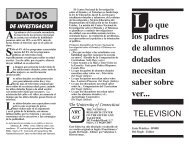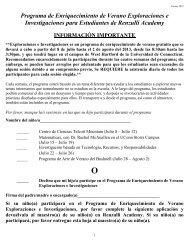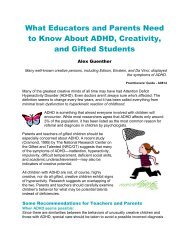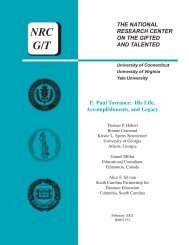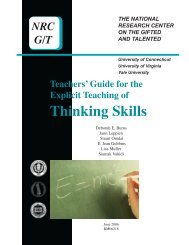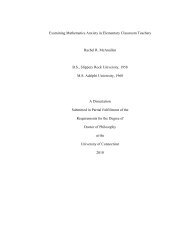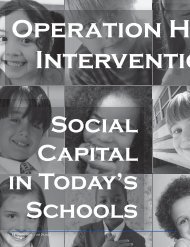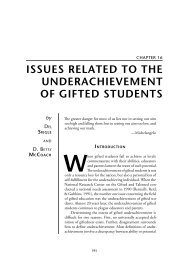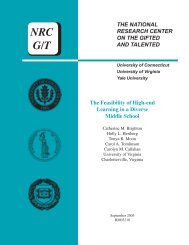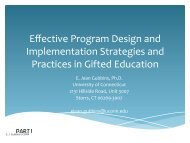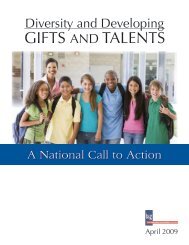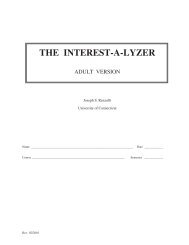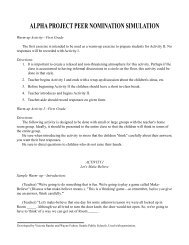Giftedness and High School Dropouts - Neag Center for Gifted ...
Giftedness and High School Dropouts - Neag Center for Gifted ...
Giftedness and High School Dropouts - Neag Center for Gifted ...
Create successful ePaper yourself
Turn your PDF publications into a flip-book with our unique Google optimized e-Paper software.
16<br />
high school, the data provide in<strong>for</strong>mation about students' high school completion status,<br />
higher education, <strong>and</strong>/or labor market choices.<br />
Because the NELS:88 data were collected using stratified cluster sampling, some<br />
groups of students, such as minority <strong>and</strong> private school students, were oversampled, <strong>and</strong><br />
different groups were included in the follow-up data collection (Keith & Benson, 1992).<br />
There<strong>for</strong>e, to obtain an accurate estimate of the population <strong>and</strong> to extend the results to the<br />
U.S. target population, variables must be weighted to compensate <strong>for</strong> unequal<br />
probabilities of selection <strong>and</strong> adjust <strong>for</strong> the non-response effect. Several weights were<br />
calculated <strong>and</strong> provided through NELS:88 CD-ROM with other variables by NCES (see<br />
National <strong>Center</strong> <strong>for</strong> Education Statistics, 1994a, pp. 38-39).<br />
In survey studies, the st<strong>and</strong>ard error is often reported as a measure of variability<br />
of estimates due to sampling. Because of the nature of the complex sample design of the<br />
NELS:88 data, the sampling error overstates the precision of test statistics in the data<br />
analyses (Czaja & Blair, 1996). To calculate the precision of the sample estimates, the<br />
design effect should be measured, then multiplied by the st<strong>and</strong>ard error to determine<br />
significance (Folsom, 1975; Folsom & Williams, 1985; Jolliffe, 1986; Kish, 1965; Moser<br />
& Kalton, 1971; National <strong>Center</strong> <strong>for</strong> Education Statistics, 1994a; Rossi, Wright, &<br />
Anderson, 1983). The design effect (DEFF) is "the ratio of the sampling variance<br />
(squared st<strong>and</strong>ard error) of a particular sample estimate using a specified (non-simple<br />
r<strong>and</strong>om) sample design to the sampling variance <strong>for</strong> the same estimate based on a simple<br />
r<strong>and</strong>om sample with the same number of cases" (Rossi, Wright, & Anderson, 1983, p.<br />
35).<br />
Research Design<br />
Since the National Education Longitudinal Study of 1988 is a nationally<br />
representative longitudinal study that includes comprehensive in<strong>for</strong>mation about<br />
dropouts, it is a valuable data set <strong>for</strong> examining influences related to gifted students'<br />
decision to drop out of school. The purposes of this study were (a) to obtain<br />
comprehensive in<strong>for</strong>mation about gifted students who drop out of school, regarding<br />
reasons <strong>for</strong> leaving school, parents' reactions, use of time, future career plans,<br />
relationships with parents <strong>and</strong> peers, <strong>and</strong> self-concept; <strong>and</strong> (b) to examine personal <strong>and</strong><br />
educational factors related to the gifted students' decision to drop out of school.<br />
To obtain these objectives, two studies were conducted using two different<br />
sources of data <strong>and</strong> samples. In Study 1, the Second Follow-up Dropout Questionnaire of<br />
NELS:88 was analyzed to obtain specific in<strong>for</strong>mation about gifted students who drop out<br />
of school. Only students who dropped out of school completed this questionnaire;<br />
there<strong>for</strong>e, gifted <strong>and</strong> non-gifted students were compared. In Study 2, student<br />
questionnaire data from the base year, the second follow-up, <strong>and</strong> the third follow-up were<br />
analyzed to examine personal <strong>and</strong> educational factors related to decisions to drop out of<br />
school by gifted students.



